This month we completed the rabies vaccinations in the Ithumba orphans following last month’s incident where a rabid dog entered the stockade and bit five of the ten orphans currently under rehabilitation
This month we completed the rabies vaccinations in the Ithumba orphans following last month’s incident where a rabid dog entered the stockade and bit five of the ten orphans currently under rehabilitation. The vaccinations involved injection of an inactivated rabies vaccine (Rabsin®) immediately after exposure (0-day), then on the 4th and 9th days, followed by weekly doses until a total of seven doses. The unexposed orphans were given 1ml on the 0-day which was repeated one month latter. No untoward reactions to the vaccinations were observed. No signs of the disease had been observed in any of the orphans at the time of preparing this report. This was 1½ months since the incident occurred. As was reported in October, the orphans were given the benefit of doubt because the bites which were on the lower parts of the hind legs were small and not deep; they had not penetrated the skin. It was therefore possible that the introduced viral load was too small to cause an infection and that the virus having not been introduced deep into the muscles, a prerequisite for it to multiply first before it invades the peripheral nerves through which it travels to the brain to cause the signs of the disease, could not establish itself. The animals will still be under close observation for any signs of the disease.
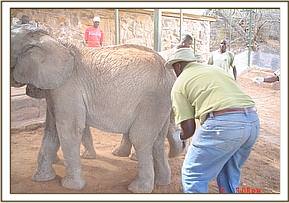

The other activity was the treatment of an 11-13 year old elephant bull at Ziwani in Tsavo West National Park that had heavily infected multiple spear wounds. Darting was done on foot because of vegetation cover which could not have allowed accessibility by vehicle. The wounds were thoroughly cleaned and treated topically and high doses of an antibiotic were given at multiple sites. The most serious wounds were at the lower right fore leg, one on each shoulder and on both rumps. There were a few minor ones on other parts of the body. The bull was also in poor body condition because the wounds were also interfering with movement and feeding. However, euthanasia was not considered then until an evaluation of the response to treatment was done. If good, a second treatment will be done and if not, the animal will be put down to stop further suffering. This evaluation was to be done after a week and the rangers stationed at Ziwani were instructed to give a daily update. So far, reports indicate that the animal disappeared soon after treatment and they have not been able to find it. The Trust’s Ziwani de-snaring team has also been requested to assist looking for it whenever they go out for their de-snaring work. Death has been ruled out as the carcass would have been seen by now. There is a possibility that the pain subsided and the animal managed to move far. The search is still ongoing.



The Unit was also called to rescue a 3-4 months old elephant calf that had been seen wandering alone in Taita Hills Sanctuary. The sanctuary personnel had monitored it for several hours before they contacted us. The exercise was carried out in conjunction with the Bura de-snaring team. It was airlifted to the Nairobi nursery and reports so far indicate that it has adapted very well to the rehabilitation programme.

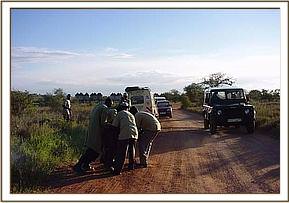

In the middle of the above rescue, an elephant family came to drink at a water hole near the lodge and the lodge staff reported seeing a 3-4 years old calf with a snare on the lower left foreleg. We responded immediately after the calf had been securely loaded onto the truck and a few keepers left behind to keep an eye. The lower part of the leg was swollen but we couldn’t tell whether the snare was still there deeply embedded or not. We therefore immobilised it for a more detailed and close examination. We found out there was no snare but there were two snare marks left either when the snare came out on their own or following some intervention. They were at the mid and lower parts of the leg. We made small but deep incisions to try establish whether they could still be deeply embedded and covered with tissues, but we did not feel them. Only blood came out when the incisions were made. There were no signs of an underlying infection. It is possible that the calf was treated long time ago and the swelling which could be due to fibrosis and exostoses (abnormal bone growth) has not receded. This condition does not resolve easily and the calf will remain lame for a long time. There was a small wound on the sole which was not serious. It was cleaned and treated and a long acting antibiotic given intramuscularly. The calf was rejoined with its family thereafter. It did not show signs of pain while walking and it could bear its full weight on the leg.
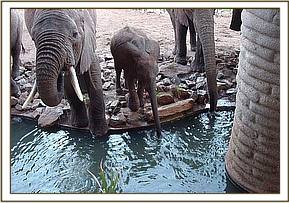
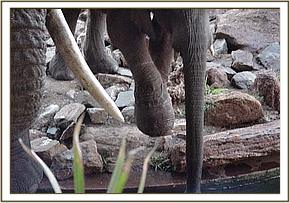
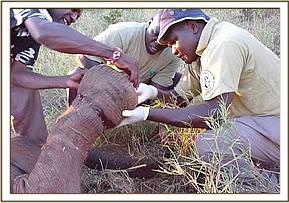

The Unit will remain closed in December for the annual leave. The KWS Vet/Capture Unit in Nairobi will handle all veterinary emergencies from the areas covered by the Unit during this period.
In its first year of operation, the Unit managed to respond to all cases that were reported. Most of these cases were successfully attended to but a few especially those which the reports were received more than a day after the animals were seen were not found. In alleviating distress by treating and rescuing all these animals, our contribution to KWS’ conservation efforts was significantly felt and appreciated by all. The year ended without any problem that affected our operations.
We wish to thank the management of the various parks and ranches for their support. We also express our sincere gratitude to the management of Tsavo East for providing a very conducive atmosphere for the Unit’s activities and provision of armed rangers for our work. Our deepest appreciation also to the Trust’s Bura de-snaring team led by Mr. Isaac Maina, for providing the Unit with additional personnel whenever requested. I wish you all a Merry Christmas and happy and prosperous 2005.